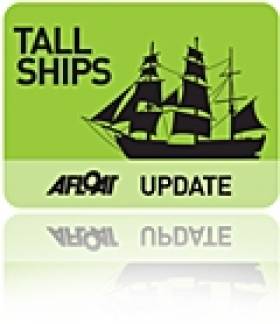Displaying items by tag: ARC Gloria
Dunmore East Bids TallShips Farewell
As the Russian 'A' class Mir passed the LE Aoife off Dunmore East in mid-morning, the largest tall ship of the festival headed the start of the Parade of Sail, writes Jehan Ashmore.
Crowds left their cars in fields outside Dunmore East and descended into the harbour and surrounding headlands to witness the highlight of the four-day festival. Adding to the scene were the numerous leisure-craft, yachts and intrepid kayakers that gathered to greet the procession which took some two hours to pass the fishing harbour.
No sooner had the fully-rigged ship Mir had slipped beyond the anchored naval vessel that the gaff schooner Johanna Lucretia, under full sail came closer into view. She was closely followed by the Ocean Youth Trust Scotland's Bermudan cutter Alba Explorer.

The Russian 'A' class Mir passing the LE Aoife off Dunmore East. Photo: Jehan Ashmore
Of all the 45 tallships participating the Columbian Navy's barque ARC Gloria presented the most colourful entrant. She proudly flew a large horizontal tricolor of yellow, blue and red representing the South American nation.
When it came to the turn of the Europa to pass the LE Aoife, the tug Bargarth gave a wonderful send-off with the traditional display of water jets shooting sky-high, nearly reaching the top of the three-masted barque.
Marking the tail-end of the parade was the Jubilee Sailing Trust's Lord Nelson, another barque that departed the estuary with the Hook Head Lighthouse forming a majestic backdrop.
At this stage several of the large tallships could be seen on the far horizon in preperation to the start of the first race leg of this years Tall Ships Races....next port of call Greenock!
- Waterford
- ship
- Dunmore East
- Lord Nelson
- Waterford Estuary
- LE Aoife
- Sail Training International
- Jubilee Sailing Trust
- Tug
- Hook Head
- Tall
- JOHANNA LUCRETIA
- TallShips
- Waterford Harbour
- JST
- Europa
- Fullyrigged ship
- STI
- ARC Gloria
- Hook Head Lighthouse
- Mir
- Gaff schooner
- Ocean Youth Trust Scotland
- Bermudan cutter
- Alba Explorer
- Columbian Navy barque
- Bargarth
- Fastnet Shipping
It's Official: Third Time Tallships for Waterford
Scenes of the tallships moored alongside the north and south quays and the surrounding festivities are captured by Gary O'Mahony. SCROLL DOWN FOR PICS.

The Columbian Navy's Sailing Training Ship ARC Gloria. Photo: Jehan Ashmore
This is the second year in which the city has been the host port of the Tall Ships Race and the prestigious event is to return for a third time. The next occasion has not been confirmed but it would be several years away according to Sail Training International, the organisers of the famous race.


























































